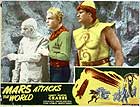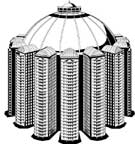So, it’s the 21st century already! Where are our George Jetson space crafts? And our personal robots? Will there ever be a real “Time Machine?” What did the future look like for our grandparents and parents? What does it hold for us? For our children?
Beginning in March 2001, “Yesterday’s Tomorrows” embarked on a five-year tour, traveling to approximately 150 small towns in 25 states. As part of the Museum on Main Street Program of the Smithsonian Institution Traveling Exhibition Service and the Federation of State Humanities Councils, these communities will connect their past and present fantasies of the future with those of other communities and with national visions of tomorrow. “Yesterday’s Tomorrows” exhibited at the Coffey County Historical Museum from June 21 to August 2, 2002.
If you missed the exhibit in Coffey County, be sure to check out the Official Yesterday’s Tomorrow Website or better still, catch the exhibit at another of the scheduled showings.
Exhibit Themes
 |
Imagine — The future exists only in our imaginations. But, during the twentieth century, Americans have expressed their imaginings about the future in books, movies, magazines, television, radio, toys, and advertising. The future presented in these media ranges from cheerful utopias of technological wizardry to dark visions of societal dysfunction. |
 |
Home of Tomorrow — During the nineteenth century, Americans thought that proper housing was essential to the future social and moral health of their families. But ideas about the home evolved; the home became a “machine for living,” and modern architecture, mass production, and increased automation within the home took precedence over real human and societal needs. Home designs continued to reflect contemporary beliefs about family life, gender roles, and social relations. Today, many home designs show exteriors that harken back to the past while their interiors are replete with the latest gadgets. |
 |
Transportation of Tomorrow — Futuristic vehicles are uniquely American ways of imagining tomorrow, reflecting our faith in progress and technology. Before the 1920s, mass transit systems dominated Americans’ visualizations of future transportation. But the automobile quickly became the dominant mode of transportation and so was the focus of designers’ and planners’ futuristic visions. |
 |
Community of Tomorrow — “Ideal” American communities envisioned in the early 20th century reflected hopes, excitement, and fears about the reality of an increasingly urban society. Strategies for future communities were marked by a series of contradictions: communitarianism v. individualism, image v. social reality, utopia v. urban chaos. Today, planned communities where work, leisure, and domestic life can be harmoniously integrated echo the communitarian utopias of the 19th century. |
